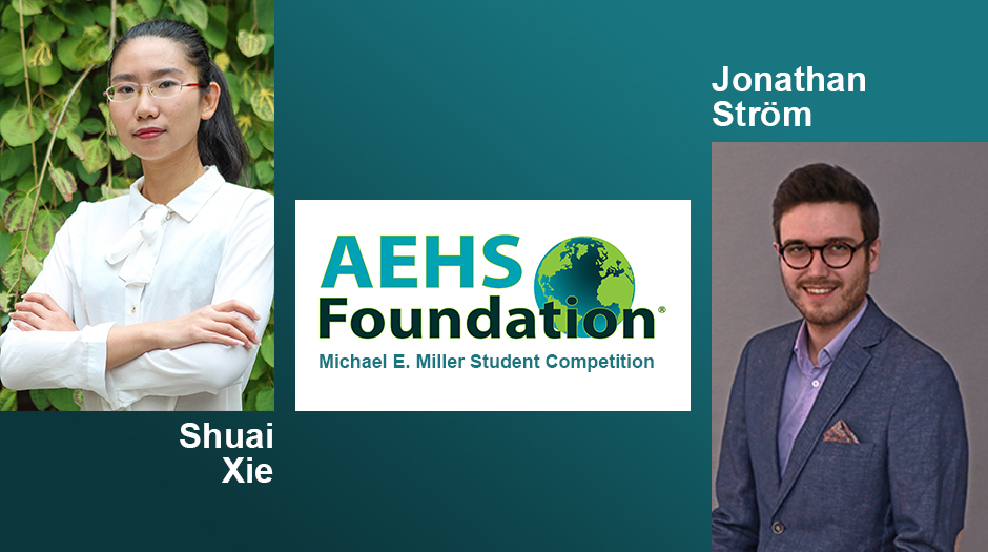 Brown School of Engineering Ph.D. students Shuai Xie Sc.M. '17 and Jonathan Ström Sc.M. '19 each were named poster prize winners at the Association for Environmental Health and Sciences Foundation (AEHS) 35th Annual International Conference.
Brown School of Engineering Ph.D. students Shuai Xie Sc.M. '17 and Jonathan Ström Sc.M. '19 each were named poster prize winners at the Association for Environmental Health and Sciences Foundation (AEHS) 35th Annual International Conference.
Xie's poster, "A Study of Trichloroethylene (TCE) Sorption on Various Building Materials" was awarded one of two $1,000 prizes, while Ström's poster "Modeling and Understanding Temporal Variability in Vapor Intrusion" took one of two $500 prizes given. The conference was held on the University of Massachusetts, Amherst campus.
Both Xie and Ström are advised by Professor Eric Suuberg.
Xie's work showed that indoor building materials can be a sink and/or source for many volatile chemical compounds (VOCs), which can affect human health. However, the sorption capacities of building materials are not generally known when the concentrations of VOCs are extremely low such as in vapor intrusion scenarios. Adsorption-related indoor contamination sources need to be distinguished from vapor intrusion sources during the evaluation of the risks of vapor intrusion. In this research, the interactions between trichloroethylene (TCE), a typical VOC of concern in vapor intrusion, with more than ten building materials were studied. The equilibrium isotherms and dynamic adsorption processes were studied using various experimental methods. Some building materials, such as concrete, showed a relatively high capacity for TCE sorption, and this may potentially affect indoor air sampling strategies.
Ström utilized long-term, high resolution studies of two vapor intrusion sites, ASU house in Utah and USEPA house in Indianapolis, which have revealed significant temporal variability in indoor air contaminant concentrations. Understanding how much, and the causes of this variability is crucial for determining human exposure at a vapor intrusion site. This study uses statistical analysis and three-dimensional numerical models to investigate the conditions that give rise to the temporal variability in indoor air contaminant concentrations. Vapor intrusion is found to be the most significant during winter and fall, with the largest variability during these seasons. The significant seasonal differences in distributions of indoor/outdoor pressure difference, air exchange rate, and other factors, help to explain the seasonal differences in vapor intrusion potential. In particular, changes in indoor/outdoor pressure difference is a key driver for the variability: independently affecting contaminant entry and air exchange rate, the combination of which gives rise to the observed variability. Using this numerical model, and the recorded seasonal mean diurnal pressure change, Ström was able to predict potential maximum temporal variability.
The posters were part of the Michael E. Miller Student Competition, and were judged by representatives from the Conference Scientific Advisory Board and representatives from the conference sponsoring organizations. Presentations were judged on originality, organization, communication, research techniques, and the overall quality of the presentation. Several evaluation factors were developed by the committee including the following: Topic Selection/Innovation, Research and Analysis Techniques Utilized, Poster Organization and Structure, Quality of Presentation Materials and Communication of Poster Content. Each presentation was ranked using a mathematical scale. Award recipients were acknowledged during the appreciation dinner at the conference.
In 2017, the AEHS Foundation renamed the East Coast Conference Student Competition in memory of the former Chair of the competition, Michael E. Miller. Miller had been an integral part of the Scientific Advisory Board, conference planning, and the student competition for many years. He was passionate about the competition and the next generation of environmental scientists who came to showcase their work at the conferences.